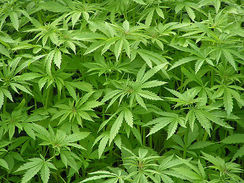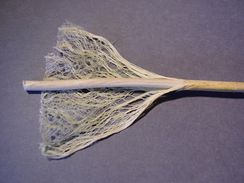Hemp: Difference between revisions
Jump to navigation
Jump to search
No edit summary |
No edit summary |
||
| Line 17: | Line 17: | ||
*replacement for plastics - '''explain''' | *replacement for plastics - '''explain''' | ||
*fuels (hemp oil / biodiesel) | *fuels (hemp oil / biodiesel) | ||
*animal feed | *animal feed | ||
| Line 25: | Line 24: | ||
File:Hempstem.jpg|The fiber can be clearly seen here. It is found between the skin and the wood of the stem. | File:Hempstem.jpg|The fiber can be clearly seen here. It is found between the skin and the wood of the stem. | ||
</gallery></div> | </gallery></div> | ||
Probably it's most important potential to society is the use of the biomass to create cellulosic ethanol. As hemp has a large percentage of cellulose in it's biomass, up to 85%. | |||
==Links== | ==Links== | ||
Revision as of 00:45, 10 April 2014
Main > Food and Agriculture > Growing plants
This page is a stub - please help expand it !
Hemp can be grown nearly anywhere. It grows very rapidly and has a lot of uses:
- Food. The seeds are extremely nutritious.
- body care (soaps)
- paper
- Textiles. Hemp fiber can be woven into a material like light cotton (suitable for T-shirts etc.) or a thick canvas material suitable for bags, warm blankets. See the page on spinning and weaving for instructions on what to do with it once harvested.
- Rope. Hemp fiber is very strong.
- hempcrete
- chemicals
- replacement for plastics - explain
- fuels (hemp oil / biodiesel)
- animal feed
Probably it's most important potential to society is the use of the biomass to create cellulosic ethanol. As hemp has a large percentage of cellulose in it's biomass, up to 85%.
Links
- North American Industrial Hemp Council
- Appropedia: Hemp
- OMAFRA: Growing Industrial Hemp in Ontario



